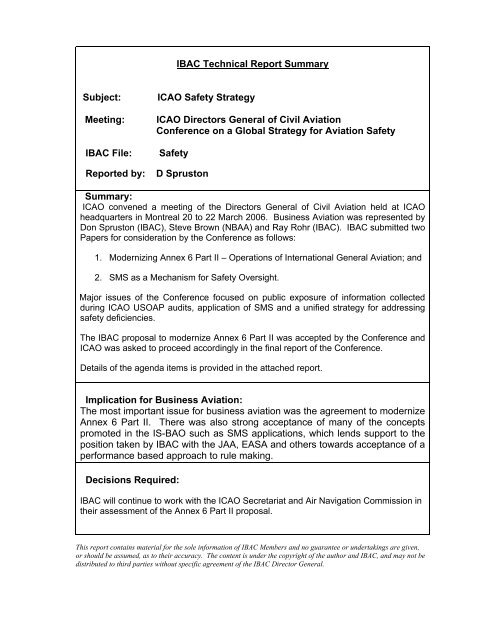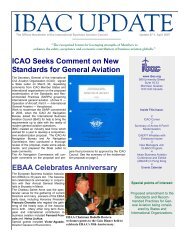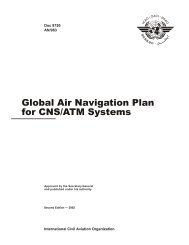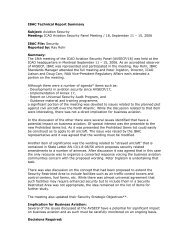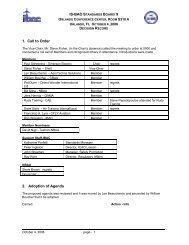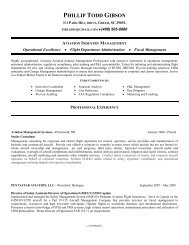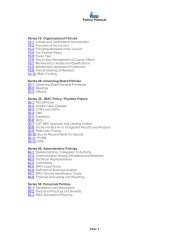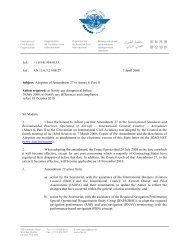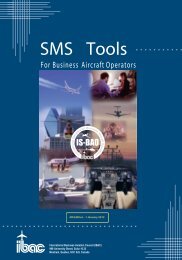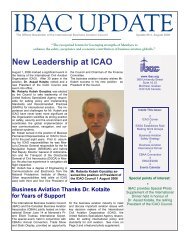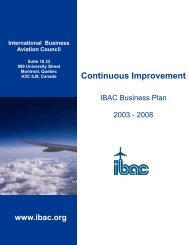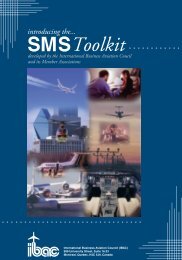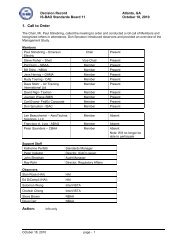IBAC Technical Report Summary - International Business Aviation ...
IBAC Technical Report Summary - International Business Aviation ...
IBAC Technical Report Summary - International Business Aviation ...
- No tags were found...
Create successful ePaper yourself
Turn your PDF publications into a flip-book with our unique Google optimized e-Paper software.
<strong>IBAC</strong> <strong>Technical</strong> <strong>Report</strong> <strong>Summary</strong>Subject:Meeting:<strong>IBAC</strong> File:<strong>Report</strong>ed by:ICAO Safety StrategyICAO Directors General of Civil <strong>Aviation</strong>Conference on a Global Strategy for <strong>Aviation</strong> SafetySafetyD Spruston<strong>Summary</strong>:ICAO convened a meeting of the Directors General of Civil <strong>Aviation</strong> held at ICAOheadquarters in Montreal 20 to 22 March 2006. <strong>Business</strong> <strong>Aviation</strong> was represented byDon Spruston (<strong>IBAC</strong>), Steve Brown (NBAA) and Ray Rohr (<strong>IBAC</strong>). <strong>IBAC</strong> submitted twoPapers for consideration by the Conference as follows:1. Modernizing Annex 6 Part II – Operations of <strong>International</strong> General <strong>Aviation</strong>; and2. SMS as a Mechanism for Safety Oversight.Major issues of the Conference focused on public exposure of information collectedduring ICAO USOAP audits, application of SMS and a unified strategy for addressingsafety deficiencies.The <strong>IBAC</strong> proposal to modernize Annex 6 Part II was accepted by the Conference andICAO was asked to proceed accordingly in the final report of the Conference.Details of the agenda items is provided in the attached report.Implication for <strong>Business</strong> <strong>Aviation</strong>:The most important issue for business aviation was the agreement to modernizeAnnex 6 Part II. There was also strong acceptance of many of the conceptspromoted in the IS-BAO such as SMS applications, which lends support to theposition taken by <strong>IBAC</strong> with the JAA, EASA and others towards acceptance of aperformance based approach to rule making.Decisions Required:<strong>IBAC</strong> will continue to work with the ICAO Secretariat and Air Navigation Commission intheir assessment of the Annex 6 Part II proposal.This report contains material for the sole information of <strong>IBAC</strong> Members and no guarantee or undertakings are given,or should be assumed, as to their accuracy. The content is under the copyright of the author and <strong>IBAC</strong>, and may not bedistributed to third parties without specific agreement of the <strong>IBAC</strong> Director General.
ICAO Directors General of Civil <strong>Aviation</strong>Conference on a Global Strategy for <strong>Aviation</strong> SafetyGeneralThe ICAO Directors General of Civil <strong>Aviation</strong> Conference on a Global Strategy for<strong>Aviation</strong> Safety was initiated by ICAO primarily due to the increased number ofaccidents that occurred in 2005. The Conference objective was development ofa global strategy for aviation safety.The Conference was opened by the President of the ICAO Council and theMinister of Transport for Canada. Dr. Kotaite was elected Chairman of theConference.Specific agenda item reports are as follows.Agenda 1The Status of <strong>Aviation</strong> TodayIn this Agenda Item, subjects included Trends in <strong>Aviation</strong> Safety, the Status ofSafety Oversight and Initiatives of States and Industry. Proposals were putforward on options for improving safety as traffic continues to grow. For example,the programs promoted by <strong>IBAC</strong> and IATA (IS-BAO and IOSA) were noted andappreciation expressed. Considerable exposure was given to the IATAdeveloped Global <strong>Aviation</strong> Safety Roadmap (this issue warrants work by <strong>IBAC</strong> todevelop something similar).Recommendations of the Conference centered around the need for States towork hard on improving Safety Oversight primarily based on the Safety Roadmapdeveloped by IATA and accepted by ICAO.Agenda 2Improving <strong>Aviation</strong> SafetyThis Agenda included Transparency and Sharing of Information, Managing of<strong>Aviation</strong> Safety, Unified Strategy to Resolve Safety Related Deficiencies, MutualRecognition and Enhancing Safety Oversight.Transparency and the public release of information from the USOAP audits wasa very controversial item. Essentially all States agreed to the maintenance of allaudit findings on a protected website for access only by States. However therewas considerable disagreement regarding the form and timing of public release.Many States agreed to the need, and their willingness, to release the informationafter the audit was completed. Others had concern with release under anycircumstances. A compromise was offered by the Chairman revolving aroundthe concept of making the information available following two years of grace toallow States time to resolve deficiencies. Concern continued on both sides
egarding the compromise. The final report provides for a two year period andafter that time the name of States that refuse to release the information will bemade public.There was extremely strong support for the application of Safety ManagementSystems in rulemaking. Considerable discussion revolved around the benefits ofa separate Annex for SMS. There was support for the need for modernizingAnnex 6 Part II and the report recommends that ICAO do so.The unified strategy proposal implied less work in the future for ICAO ondeveloping SARPS and more on implementing existing Standards andassociated provisions. The elements of the strategy includes a partnershipprogram, COSCAP, audits and corrective actions, information exchange andother sharing mechanisms. A good briefing was given on the new ICAOdatabase for safety information exchange (FSIX). It was recommended thatregional and sub-regional safety oversight organizations, States coordinate re theUnified Strategy and that regions exchange information through FSIX.The mutual recognition discussion emphasized the need for cooperation onUSOAP, and the need for a mechanism for resolving significant safety concerns.The concept of a pool of international safety oversight capacity was discussedalong with the need to allocate funds for the unified strategy in the next budget.There was support for the need for funds and ICAO to provide assistance.Consideration will be given in preparation of the next budget.Agenda 3Beyond the Current FrameworkThis agenda item centered on the needs of modern day aviation, which featureseconomic liberalization. Of particular interest there was agreement to addressthe relationship between the operator and regulator. A recommendation of theConference included the need to better define the operator and State of theoperator. It was agreed that there was a need to review the Annexes to ensurethat safety objectives were addressed and that States had adequate flexibility. Anumber of specific recommendations were made in this regard..It was also agreed that technical cooperation needs more focus and flags ofconvenience situations should not be tolerated.It was agreed to develop a new Annex on Safety Management Systems.


